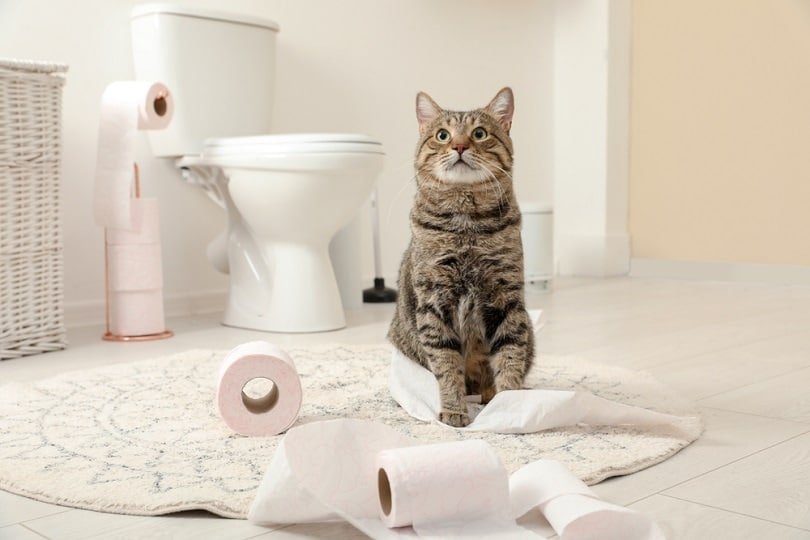
[adinserter block=”1″]
Cats are notorious for unraveling and shredding toilet paper, driving many a cat parent to despair. If your cat is wreaking havoc in the bathroom, it’s time to start looking into how you can cat-proof your toilet paper holders and redirect your kitty’s impulses onto something more appropriate.
In this guide, we’ll walk you through your options and share some tips on understanding and preventing this behavior.
Methods for Cat-Proofing a Toilet Paper Holder
If it’s simply not possible to keep your cat out of the bathroom, you can either DIY your own toilet paper holder protector or buy one. Let’s take a closer look at both of these methods.
1. DIY Toilet Paper Holder

You can easily fashion a toilet paper holder protector out of a few bits and bobs you have around your home. Here’s an example of how to make a basic one, but feel free to get creative—there’s more than one way to do it.
What you’ll need:
- A plastic, tube-shaped container (like a big soda bottle or wipe container)
- Scissors/box cutter
- Ruler
- Decorative items (optional)
Steps
- Clean the plastic container and take off any labels.
- Cut off the bottom and top halves of the container to get a tube around 4 inches wide (the width of a toilet paper roll).
- Cut a line through the plastic tube so that it opens up, which will allow you to curl it around the toilet roll later.
- Trim one end of the plastic tube to make sure it’s smooth.
- Bend the trimmed end backward by half an inch or so to create the part where the toilet roll slides out when you pull.
- Curl up the tube with the bent end on the outside and hold it for a few moments to tighten it up. This allows it to fit more snugly over the toilet roll.
- Pop some stickers or other decorations on to brighten it up, if you like.
- Place your DIY protector over the toilet paper. Don’t worry if it slides a bit—it shouldn’t be so tight that you can’t pull the toilet paper out.
2. Commercial Toilet Roll Covers

If you’re not a fan of DIY at all, you can always buy a toilet roll protector. While researching, we even came across some that were designed specifically with cat-proofing in mind, and these types are often completely covered but with a flap at the front or bottom.
These may help prevent the cat from getting at the toilet paper from most angles, but they’re not always catproof. Cats are smart, and many will quickly learn how to lift the flap or attack the bottom where the toilet roll is hanging out.
As an alternative, you could look for a toilet roll holder box that allows you to pull the paper out from a hole in the top and simply cover this hole with something when not in use, or store your toilet roll in a covered container, only taking it out when necessary.

Why Do Cats Attack Toilet Roll?
The answer to this is very simple: It’s fun. Cats love playing with toilet paper rolls because of the movement when they unravel and how easy they are to shred, and this is all very tantalizing for an animal with hunting instincts. If your cat frequently engages in this behavior, they could be in need of more mental stimulation in the form of play sessions with you and interactive cat toys.
Try getting a selection of new toys like balls, chaser wands, catnip toys, puzzles, and treat-dispensing toys to redirect your cat’s energy onto. Don’t forget to play with your cat a few times a day, too, and give them enough attention so they don’t feel ignored.
Cats should also always have access to a scratching post, as scratching is an important behavior for them. You can even try placing one in your bathroom or outside the bathroom door if this is where your cat gets into the most mischief.


Final Thoughts
Toilet paper is often among the first victims of a mischievous kitty, but with a few simple changes like those described in this guide, you can keep it safe from harm!
On a final note, bear in mind that while scratching at and unraveling toilet paper is typically just a form of play, chewing toilet paper may indicate that a cat is feeling unwell in some cases. Keep an eye out for signs of illness and contact your vet if you suspect something is amiss.
Featured Image Credit: New Africa, Shutterstock
[adinserter block=”1″]
Credit : Source Post






